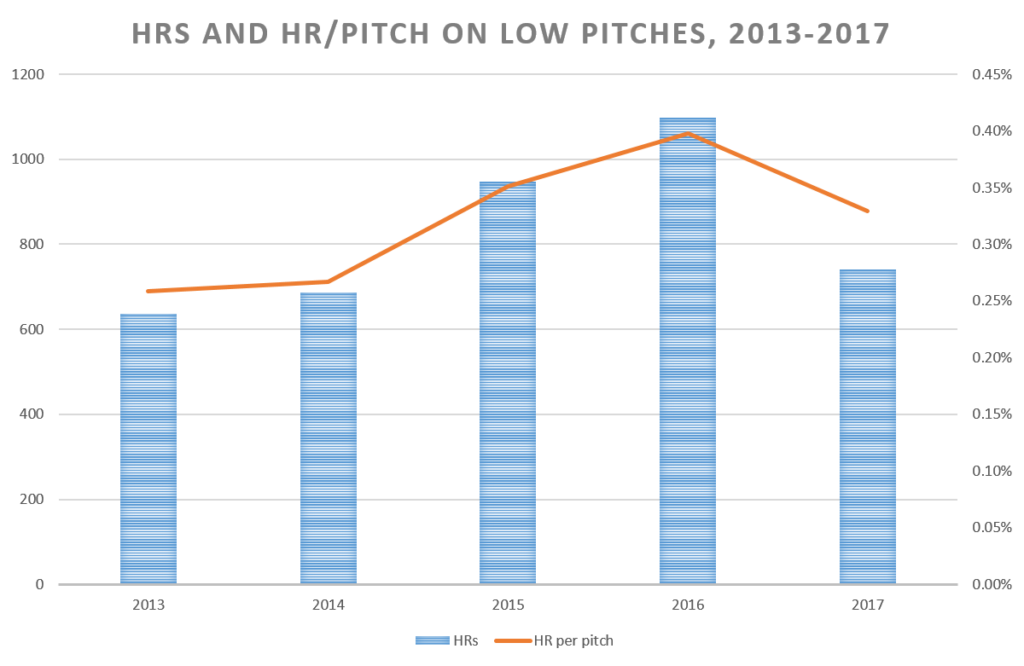Walking Into an Ambush
The 2016 season’s finished, and you and a group of M’s baseball ops staffers are talking about how to change direction for 2017. The Mariners allowed a ton of HRs, and Safeco – the impregnable, right-handed-power-destroying citadel – had seen the most HRs hit of any park in the game. Given your financial and minor league talent constraints, acquiring elite talent through free agency (not that this was on offer, really) or trade wasn’t likely. “What does the data say?” someone asks, and heads turn in your direction.
Let’s do this, you say to yourself, and gulp some water. You’ve brought slides. Sweet, irrefutable trend analysis. The HR revolution is real, but it is highly localized. Run scoring is increasingly due to HRs, and more and more HRs are being hit. But HR rates at the top of the zone are unchanged. The HR revolution or air-ball revolution or whatever you want to call it is a phenomenon restricted to the bottom of the zone.
Here’s the total number of HRs hit on high pitches, where high is defined as at least 6″ above the center of the zone. The absolute number of HRs hit on pitches in this zone has dropped, and while the rate of HRs per pitch is fairly high, it’s not rising, and is actually a bit below rates from 2013, a low-run-scoring season. Compare that to the trend for *low* pitches. Here, in a single chart, is the story of the HR glut in baseball:
The absolute number of HRs hit on pitches 6″ *below* the center of the zone starts off far lower than the high pitches, but it blows past the high pitches in 2015, and it keeps growing. On a per-pitch basis, the rate’s now approaching the same rate as the high pitches, and remember there are far, far more pitches thrown in the low zone; in 2016, two pitches came in the low zone for every one pitch in the high zone. If that’s too broad, we’ve re-done the analysis using Statcast’s new detailed zones and eliminated wide pitches. If anything, the results are even more stark. HR/P in the lowest zones increased markedly between 2015 and 2016. The data are clear: if you want to avoid HRs, and remember that avoiding HRs means avoiding runs-allowed, you need to target pitchers who pitch up in the zone. Batters have gone all-in on the low pitch, and their swings are tailored to damage these pitches specifically. Pitch up, and you gain increase whiffs and decreased batting average against, while the big drawback of pitching up – namely, a much higher SLG%-against- isn’t really there anymore. You should look at guys like Drew Smyly, and we definitely need to get the message to Felix.
I’ll be honest, there’s a potential problem. If something meteorological or otherwise has happened and Safeco is now an especially EASY park to homer in instead of an incredibly difficult one, then this could backfire. But that’s crazy, right? It’s still at sea level, right by Puget Sound and that thick marine layer. Yes, HRs spiked there in 2016, but all the statcast park factors say it’s a pitcher’s park. It’s a risk, but it’s not a crippling one. Oh, almost forgot: to really maximize the value of Safeco and pitching up, we need a really athletic, Kansas City Royals-style outfield. BABIP-against is going to be pathetically low, and that can mean that even if injuries happen, our depth guys will look better than their raw stuff or FIP would predict.
:2017 Season happens:
Sssoo, I got your e-mail, and yes, I’ve updated the charts I shared back in January with 2017 data. I…I don’t know..there are many possible..what? Right, right, yes sir. Uh, high pitches:
Yes, the giant leap in 2017 does rather catch one’s eye. Ok, low pitches now:
Sooo, the bit about the HR revolution being localized may, and I stress that this is all preliminary and that we need much more data, MAY have been overstated. Perhaps. It would…appear, that batters are now better at elevating and punishing pitches of all types, but that in 2017, they’ve done the most damage on, uh, pitches that are thrown, um, rather higher. It’s the damndest thing.
I said that the risk was that Safeco became truly HR-friendly, and while it’s seen a ton of HRs, I’d like to point out for posterity that our pitchers have given up far more HRs on the road. Safeco hasn’t been the issue. I would also like to point out that our ERA really is better than our FIP, and that Jarrod Dyson and company can really go get it, and it is amazing to watch. Bloggers who worried about there not being enough fly balls in play have been thoroughly shamed, as I suspected. Ha! What’s that? Our team fWAR from pitchers? Yes, 7.5, 25th in the league. There’s clearly room for improvement. Our HR/9 ranks 28th, and no, I didn’t see that coming; very sorry, sir. I really, really thought we had this whole fly-ball revolution thing sussed. Won’t happen again; I’m already for looking for new trends, and hoping they are much longer lived, sir.
————————————
I’ve been frustrated with the M’s this year, and their lack of consistent pitching that goes far beyond the injuries they’ve suffered. Sam Gaviglio just pitched a gem for the Royals as I wrote this, while the M’s struggled to get anything from higher-tier prospects and trade targets. The key has been the HR ball; the M’s have given up way too many, and it’s killed their playoff hopes. I sometimes find myself damning the front office for this, or for failing to really understand what was going on in baseball generally and at Safeco in particular: you couldn’t count on running a low HR/FB ratio, not in 2017 anyway. Great strategy for 2010, Jerry. From what I’ve heard of his talk at LL night, Dipoto seemed to admit as much.
But the more I’ve thought about it, the more I would’ve said the exact same thing as the unfortunate baseball-ops intern in the hypothetical above. Hell, I *did* say as much in that post about Felix. This really did seem like a change in how batters attacked pitches in a specific location. And then this year, all of the sudden, it wasn’t. Jeff has a post today about baseball moving away from the sinker, and a correlated fact came through in my research: pitchers are throwing fewer low pitches this year. It makes some sense, as the strike zone’s no longer expanding to the south, and as more and more have become aware of hitters’ increasing propensity to turn low pitches into souvenirs. I have no real explanation for their sudden increased ability to swat high pitches for HRs; it’s come much too late to have anything to do with the ball, which seems to have changed earlier on. And the ball itself wouldn’t explain the DROP in HR/pitch on low pitches from 2016 to 2017. This is a shift in where batters are doing damage, a reversal of a similar (inverse) shift a few years ago.
I have no idea why this is happening, or if it’ll continue next year. What I can say is that I understand the motivation behind the M’s offseason a bit more, and I have to admit that my own writing and surmising would’ve been supportive. There was no real clear sign of danger, beyond the traditional “the HR/pitch rate is high up in the zone.” This may be the result of the human tendency to find patterns in random variation, and it may be the result of a shift in batting instruction. Whatever the cause, the M’s identified what they saw as a potential improvement, and they implemented it well. I’ve been extremely critical of this FO’s ability to implement its own plans, but credit where it’s due: they set out to increase fly balls and improve OF defense, and they have absolutely done that. But they had no idea that they were walking into an ambush – that baseball would see a spike in HR/FB just as they successfully developed a fly ball staff. No one ever said being a GM was fair, but…damn. Tough break, Jerry.





Enjoyed this, Marc. As always with your best posts, a lot of other things come to mind as I’m reading along. The oddest one, this time, was a memory of a conversation with a real estate agent, who at the time was advising some people we knew to hang tough, that one of the common dangers with clients reacting to disappointing initial responses, was to begin “chasing the market down”. I know, that has little to do with the idea of an FO analyst looking at trends, and promoting an idea going forward to adjust to trends. Except in one way: that that analyst, doing that and thinking they are looking at the big picture from a unique and isolated vantage point, isn’t taking into account that everyone else … is doing the same thing. In terms of batters, and batting coaches, it’s more likely they all spotted the trend, too, and knew that as that trend became obvious, everyone everywhere would be compensating, i.e. especially pitchers would lift their zones. (In real estate, the resistance is created by simply convincing clients that each house is unique, and it’s the agent’s job to determine how to best identify and sell the unique/best qualities.) I guess, what I mean, is that an off-the-rack pitching approach, tied to trends, is a crap shoot. Me, I think a fly ball outfield staff is going to be a plus, no matter what’s going on. But tight focussing pitching approach doesnt feel right.
Although just plain bad pitching tends to blow all of the above ruminations straight out of the water.
Forgive me for my ignorance, but doesn’t a lot of the issue simply have to do with the lack of quality stuff from our starters? Miranda, Gallardo, and Moore all lack deceptive third pitches. It really appears that opponents simply squared up far more offerings from those three specifically.
And then there’s the walks.